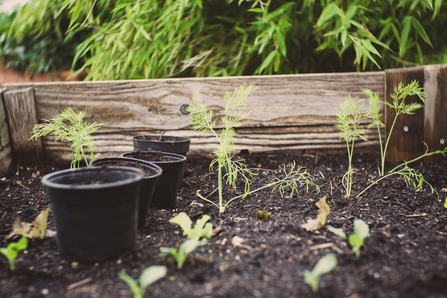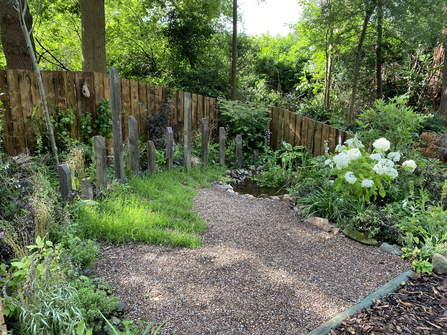
Illustration by Corinne Welch
Climate friendly gardening
There are plenty of ways you can take action against climate change in your own backyard or local greenspace.

Reduce your flood risk
Across the UK 1.9 million people currently live in areas of significant flooding. This number could double as early as the 2050s. But there are practical ways that you can reduce the damage flooding will cause.
- The RHS estimate that a quarter of homes have hard paved garden creating huge flooding risks. Make a difference and avoid paving over sections of your gardens. Instead, replace hard surfaces with grass and plants. Borders and lawns soak up the rain and help reduce flood risk. Even using pebbles and stones is better than concrete or slabs as it provides some drainage.
- Be diverse in your planting. Some plants love wet conditions in the summer while others soak up water in the winter. By growing a mixture of plants you can help improve water absorbtion throughout the year.
- Create an eco-friendly driveway. Do some research into permeable paving or laying down grids on top of a grassy drive to prevent it getting muddy. You can also plant up a drive or walkway with shrubs and grasses that will withstand a bit of impact. For example thyme (Thymus serpyllum), creeping jenny (Lysimachia nummularia), bugle (Ajuga reptans) and grape hyacinths (Muscari armeniacum).
- If you need a solid surface gravel can be one of the more wildlife-friendly options.
- Opt for a hedge, not a fence. Hedges are a better choice of boundary for wildlife than fences or walls as they absorb water, heat and CO2. Not only that, but they allow wildlife to move about between gardens and other spaces, and provide feeding and breeding opportunities. Get started growing your own hedge.
- Find out if you are in an at-risk area and sign up to flood warnings in your area.

©Katrina Martin/2020VISION
Reduce your heat risk
Currently around 20% of homes are at significant risk of overheating. There are more than 2,000 heat-related deaths per year across the UK, and this could more than triple by the 2050s without additional adaptation action. Here's what you can do to make a big difference!
- Plant more greenery around your house. Shrubs and trees have a great cooling effect.
- Grow a mini meadow. This means mowing less often over the summer. Longer grass is fantastic for wildlife and great at cooling down the garden! Here's how to get started.
- Grow plants up walls. Climbers such as roses, ivy, clematis, jasmine and honeysuckle a great for wildlife and for cooling down external walls. Here's how to create your own vertical garden.
- Make sure you maximise the ventilation and shading around your home as much as possible during the summer. If you rent or live in social housing, send a formal notification to the landlord if you experience overheating. Buying a simple thermometer will help you keep track of the indoor temperature.

Markus Spiske, Unsplash
5 more top tips to help the climate in your backyard!
- Avoid tools such as lawnmowers that use fossil fuels to run.
- Invest in a water butt. Collect rainwater all year round and use it to keep your plants hydrated over the summer months. Here's how to get started.
- Compost your waste. Creating your own compost and adding it to plants improves the soil's ability to stabilize carbon. It also increases plant growth - therefore absorbing more carbon dioxide from the atmosphere. Get started composting.
- Only buy peat-free compost. Peat is dug out of wild places, damaging some of the last remaining peatlands. This process also releases carbon into the atmosphere, accelerating climate change. Make a difference by going peat-free in your home.
- Grow your own flowers. Growing your own roses, daffodils and sweetpeas is a lovely way to avoid the carbon footprint of cut flowers sold in shops.




